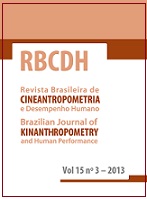The use of hand paddles and fins in front crawl: biomechanical and physiological responses
DOI:
https://doi.org/10.1590/1980-0037.2013v15n3p382Abstract
Paddles and fins are used during swim training and practice as tools for improving performance. The use of these equipment can alter physiological and kinematic parameters of swimming. The purpose of this literature review was to present and discussthe effects of paddles and fins on kinematic and physiological variables in front crawl,and provide update on the topic for teachers, researchers, coaches and swimmers. Thirty articles were reviewed. To crawl, paddles can change the averages of stroke length and stroke rate, the average swimming speed, the absolute duration of the stroke phases and the index of coordination. Fins can modify the average stroke rate, the average swimming speed, the kick frequency and deep, and the energy cost. We found no studies that verified the longitudinal effects of the use of paddles and fins on these parameters.



